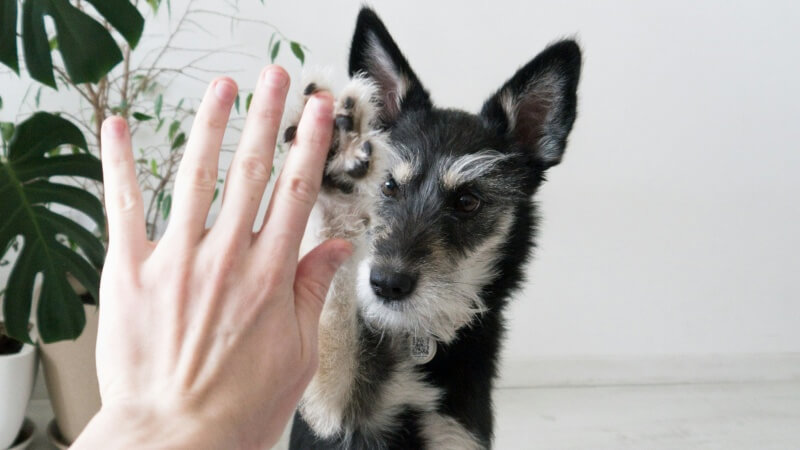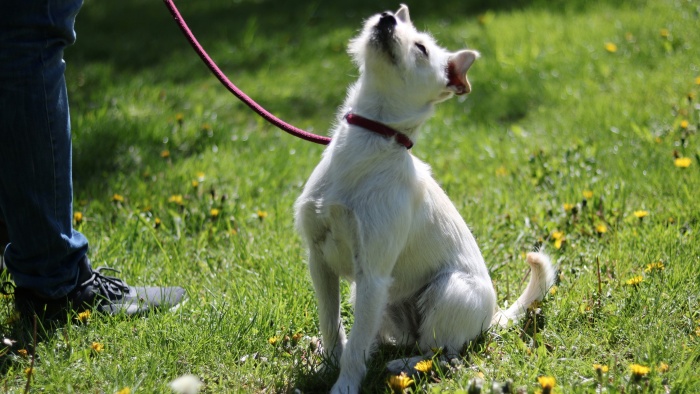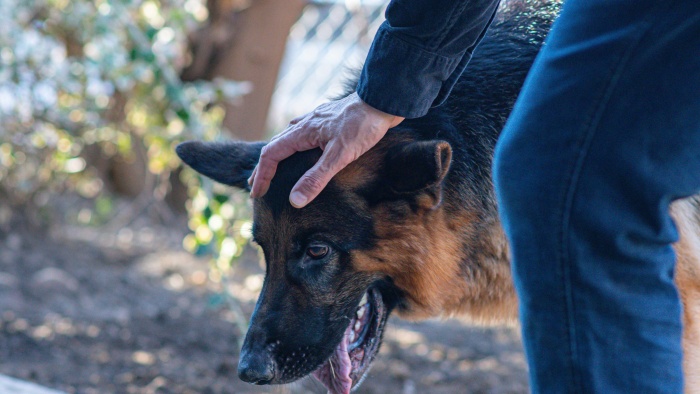Tricks To Teach Your Dog:12 Types

Training your dog in new tricks to teach your dog is key for pet parents. It aids in the development of impulse control and keeps them mentally and physically active.
Educating your dog enhances their skills, betters their conduct, and expands their understanding. A dog that can consistently obey a command will interact more positively with other dogs and people.
Here are 12 simple tricks that most dogs can learn for improved behavior.
Sit
“Sit” ranks as an effortless trick every dog owner should teach. It serves as a foundation for most canine tricks.
Mastering “sit” paves the way for your pet to learn more complex tricks. Teaching “sit pretty” can be an amusing trick to show off to friends and family.

Training your dog to sit
Use a high-value treat as a lure. Begin by holding a treat near your dog’s nose while they stand. Gradually raise the threat above their head towards their back. This movement naturally guides your dog into a sitting position as they track the treat.
Incorporate the command. The moment your dog sits, say “sit,” reward them with the treat, and offer verbal praise like “yes” and “good.” Repeat until your dog sits on command.
Stay
“Stay” is a fundamental trick for dogs. This command is useful for keeping your dog near you or preventing them from approaching people or other animals.
It aids in developing impulse control in young dogs. As they age, they will continue to use this trick effectively.
Training your dog to stay
Begin with “sit.” Start with your dog standing. Command them to “sit.” Once they are sitting, reward them with a treat and praise.
Introduce the command. With your dog seated, say “stay.” Pause for a few seconds. If your dog remains seated, use their release word and reward them.
Extend the time. Gradually increase the time between the command and the reward. Once your dog understands to stay, try commanding and moving away.
Release and enhance. As they master “stay,” extend the duration, introduce distractions, or leave the room for more challenge.
Release words
Professional trainers often use release words to end a command. Introduce a release word to signal the end of the trick.
Common release words include:
“O.K.” “Release” “Go” “Break” “Free”
Choose any release word. Practice “stay” until mastered, then incorporate the release word. Continue until your dog stays until the release word is said.
Come
Training your dog to respond to a call is an important aspect of dog training. It’s worrying when a dog runs away and doesn’t return on command.
The “come” or “here” command is vital for safety. It’s useful if a dangerous animal or another dog is near, allowing you to call your pet away from harm.
Moreover, mastering this trick eases your mind when your dog is unleashed. They can freely explore and return to you when needed.
Teaching your dog to come on command
Create distance. Begin by standing a few yards from your pet.
Issue the command. Call your dog’s name followed by “come” or “here.” Encourage them with positive reinforcement like cheering or saying “good dog!” as they approach.
Reward and repeat. When your dog arrives, reward them with a treat and physical affection to show approval. Use your pet’s release word, then pause before practicing again.
Leave it
“Leave it” trains your dog to ignore unfamiliar items on the ground, ensuring their safety. For instance, if your dog encounters potentially harmful items like dropped food or medicine, the “leave it” command prevents them from hastily consuming it.
Once proficient in “leave it,” your dog will seek your permission before eating anything off the ground.
Teaching your dog to leave it
Use a tempting treat. Start by placing a treat in your closed hand and set it on the ground, saying “leave it.” Let your dog attempt to get the treat until they desist.
Praise for compliance. When your dog stops trying, praise them, say their release word, and then allow them to have the treat.
Continue practicing until your dog ignores the treat for several seconds. Progress to using an open hand with the treat.
Increase difficulty. Once they reliably leave the treat in your open hand, drop a treat on the floor and command “leave it.” Pause, then use the release word to permit them to take it. Always offer plenty of praise and positive reinforcement.
With further practice, your pet will learn to resist temptation until you use the release word or remove the unwanted item.
Down
Knowing the “down” command is beneficial in daily situations. It’s crucial when you need your dog to stay still, like during vet visits or when guests arrive. “Down” is an important trick for your dog to master.
Teaching your dog to lie down
Begin with “sit.” Start with your dog standing in front of you. Command them to “sit.” Once seated, hold a treat between your fingers for them to see.
Entice with a high-value treat. Slowly lower your treat-holding hand to the floor in a straight line. Your dog will follow the treat. When your hand reaches the floor, gently pull it towards you.
Introduce the command. As your dog follows the treat, they should naturally lie down. Once they do, say “down,” and reward them. Offer extra affection and their release word to indicate the end of the trick.
Repeat until your dog lies down on command. After mastering “down,” you can teach them to army crawl or stay in position.
Place
“Place” is a valuable trick for calming your dog. It’s helpful when your dog needs to stay out of the way, like while cooking or when visitors arrive.
The “place” command can address issues like begging or jumping on guests. Teaching “place” provides a positive alternative, preventing such behaviors.
Teaching your dog place
Master the basics. Ensure your dog knows how to sit, lay down, and stay. They should also recognize a release word to leave their place.
Introduce their place. Show your pet their bed, crate, or hula hoop, rewarding any interaction like sniffing or standing on it. Lure them onto the bed or into the crate with a treat.
Implement the command. When your dog steps into their place, say “place” and reward them. After a short time, use their release word to free them.
Extend duration. Gradually increase the time between action and reward. Command “stay” while they’re in their place and step away. Use the release word, then reward them.
Introduce challenges. Once accustomed to “place,” add difficulties like:
- Having them lie down
- Shaking their dog harness
- Knocking on the door
- Creating noise
- Squeaking a toy
Reward them for staying put through distractions before using their release word.
Soon, your dog will associate “place” with not just touching their bed but also lying down and staying until hearing their release word.
Back up
“Back up” is a maneuvering trick that teaches dogs to use their bodies safely and effectively. Most dogs don’t naturally walk backward, making this a learned skill.
“Backup” is useful in tight spaces or when creating space around guests.
Teaching your dog to back up
Choose a spacious area. Start in a roomy area like a hallway or outdoors to teach this entertaining trick.
Step and reward. Stand in front of your dog as they stand. Step towards them and reward them with a treat when they step back with their hind legs.
Incorporate the command. After several tries, add the command “back” or “back up.” With repeated practice, your dog should back up on hearing the verbal cue.
Shake paws
Teaching your dog to shake paws is a charming and simple trick. “Shake” is an excellent trick for social times with friends and family.
Teaching your dog to shake hands (paws)
Begin with “sit.” Start by having your dog sit. Hold a treat in your closed hand just beyond their reach.
Introduce the command. Say “shake” while gently tapping one of your dog’s front paws. Dogs often lift their other paws to reach for the treat.
Catch and reinforce. When your dog lifts their paw, catch it. Say the command and reward them. This helps your dog link the command to the action.
Continue these steps until your dog lifts their paw on command.

Play dead (or rollover)
“Play dead” is a delightful trick, though not as fundamental as “sit,” “shake hands,” or “stay.” It’s a great way to add variety to your pet’s repertoire. If your dog knows “down,” they can learn this trick easily.
Teaching your dog to play dead
Start in a lying position. Use “down” to have your dog lie down.
Entice with a treat. Hold a treat near your dog’s nose and move it to the side, encouraging them to roll onto their side.
Reward the action. When your dog lies on their side, give them a treat. Repeat this to familiarize them with lying on their side.
Introduce a command. After mastering the first step, add a verbal cue like “play dead” or “bang.”
Bonus! Add a hand signal. Some owners pair this trick with a hand signal, like mimicking a gun with their fingers. Once your dog links the command to the action, reward them.
Speak
Barking is a natural form of expression for dogs. However, pet owners often need their dogs to be silent. Dogs typically bark at:
- Seek attention
- Communicate with other animals
- Express territorial behavior
Teaching your dog to “speak” on cue can manage impulse control and reduce excessive barking.
Teaching your dog to speak
Tempt with a desirable reward. Position your dog in front of you, showing that you have something they want, like a tennis ball, a favorite toy, or a treat.
Await a reaction. If your dog knows other tricks, they might try several to get the reward. In excitement or frustration, they may bark or make noise.
Cue the bark. When your dog barks, use the command “speak” and reward them. Repeat until they understand to “speak” on command.
Take a bow
The “bow” command is often a natural pose for many dogs, especially those who stretch frequently. Instead of merely admiring their stretch, use “bow” or “take a bow” to turn it into a trick.
Teaching your dog to take a bow
Entice with a valuable treat. Have your dog stand in front of you. Hold a treat near their nose and gradually lower it to the floor. Their nose should track the threat downwards.
Incorporate the command. As you lower the treat, say “bow” or “take a bow.” When your dog’s front legs are down and their hind legs remain upright, reward them. Repeat until your dog performs this trick on command.
Spin
“Spin” adds an enjoyable element to your collection of dog tricks. While not crucial, it’s a delightful trick to teach your new dog.
Teaching your dog to spin
Entice with a tempting treat. Begin by holding a treat near your dog’s nose. Gently move it towards the side of their head, encouraging your dog to turn and follow the treat.
Introduce the command. As you guide the treat, say “spin.” Continue moving the treat in a full circle until your dog completes a full spin.
Reward the action. After returning to the starting position, give your dog a treat. Repeat until your dog can spin in a complete circle using just the verbal command.
Final tips for teaching your dog tricks
With these beginner-friendly tricks learned, it’s vital to keep in mind some key tips to aid your progress:
- Maintain brief training sessions.
- Begin with fundamental commands before progressing to more playful tricks.
- Limit training to 15 to 20 minutes, once or twice daily.
- Utilize portions of your dog’s regular food or supplements as training “treats.”
- Schedule training near meal times to avoid overfeeding.
Training in behavior and tricks is an excellent way to engage your pet’s mind and strengthen your bond. Remember, patience is key as not every dog learns at the same pace, so be consistent and enjoy the process.

Conclusion
In summary, these tricks to teach your dog offer a variety of benefits. They not only enhance your dog’s obedience and behavior but also strengthen the bond between you and your pet.
Each trick, ranging from basic commands like “sit” and “stay” to more entertaining ones like “spin” and “play dead,” contributes to your dog’s mental and physical stimulation. Remember, consistent and patient training is key.
By keeping sessions short, using part of their regular meals as treats, and gradually building up from basic to more complex tricks, you ensure a fun and rewarding experience for both you and your dog.
As you progress, your dog’s skills will improve, and you’ll see a positive change in their behavior and interaction with others.
FAQs
FAQ: How often should I introduce new tricks to my dog during training sessions?
It’s best to focus on one trick at a time. Once your dog has mastered a trick, you can introduce a new one. The learning pace varies with each dog, so be guided by your pet’s progress and enthusiasm.
FAQ: Can older dogs still learn these tricks, or are they just for younger dogs?
Absolutely! Older dogs can learn tricks too. It might take a bit more patience and time, but with consistent training, they can successfully learn new commands.
FAQ: What should I do if my dog loses interest in the middle of a training session?
If your dog seems disinterested, it might be time to take a break. Keep training sessions engaging and positive, and always end on a high note, even if it’s just revisiting a trick they already know well.
FAQ: Are there specific treats you recommend for training sessions?
Use small, low-calorie treats that your dog loves. The treat should be enticing enough to hold their attention, but not so large or rich that it distracts them or leads to overfeeding.
FAQ: Is it better to train my dog before or after they have had their regular meal?
It’s often more effective to train before meal times. A slightly hungry dog may be more motivated by treats. However, ensure the dog isn’t too hungry or too full, as both can distract from learning.

